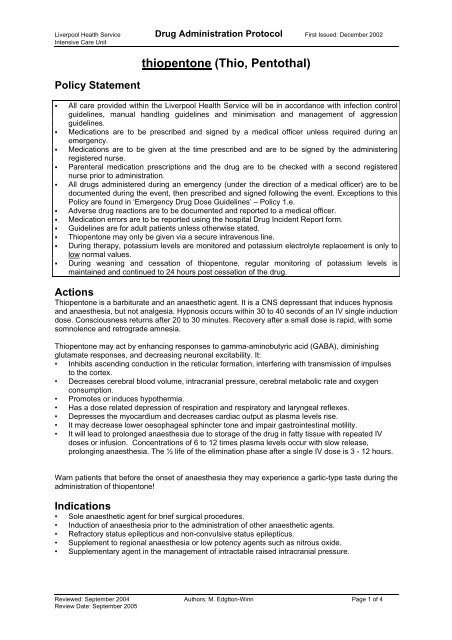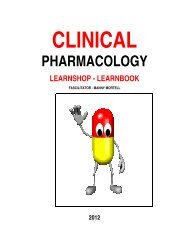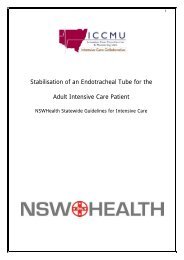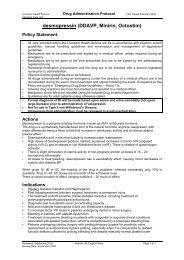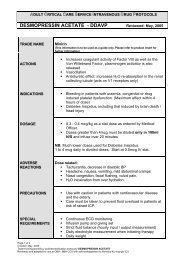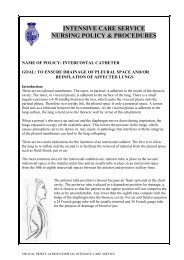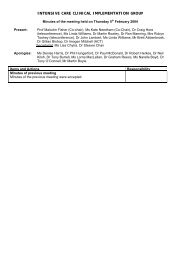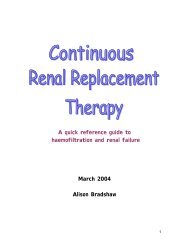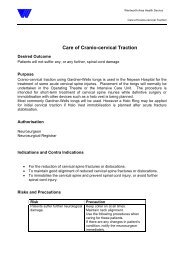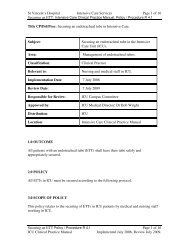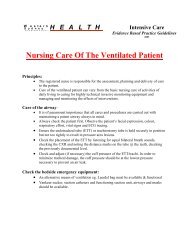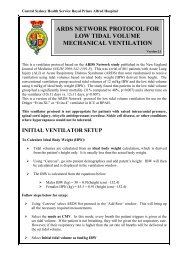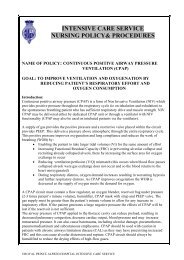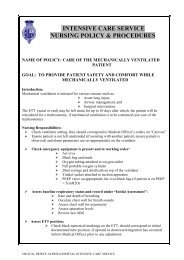thiopentone - Intensive Care & Coordination Monitoring Unit
thiopentone - Intensive Care & Coordination Monitoring Unit
thiopentone - Intensive Care & Coordination Monitoring Unit
You also want an ePaper? Increase the reach of your titles
YUMPU automatically turns print PDFs into web optimized ePapers that Google loves.
Liverpool Health Service Drug Administration Protocol First Issued: December 2002<br />
<strong>Intensive</strong> <strong>Care</strong> <strong>Unit</strong><br />
Policy Statement<br />
<strong>thiopentone</strong> (Thio, Pentothal)<br />
• All care provided within the Liverpool Health Service will be in accordance with infection control<br />
guidelines, manual handling guidelines and minimisation and management of aggression<br />
guidelines.<br />
• Medications are to be prescribed and signed by a medical officer unless required during an<br />
emergency.<br />
• Medications are to be given at the time prescribed and are to be signed by the administering<br />
registered nurse.<br />
• Parenteral medication prescriptions and the drug are to be checked with a second registered<br />
nurse prior to administration.<br />
• All drugs administered during an emergency (under the direction of a medical officer) are to be<br />
documented during the event, then prescribed and signed following the event. Exceptions to this<br />
Policy are found in ‘Emergency Drug Dose Guidelines’ – Policy 1.e.<br />
• Adverse drug reactions are to be documented and reported to a medical officer.<br />
• Medication errors are to be reported using the hospital Drug Incident Report form.<br />
• Guidelines are for adult patients unless otherwise stated.<br />
• Thiopentone may only be given via a secure intravenous line.<br />
• During therapy, potassium levels are monitored and potassium electrolyte replacement is only to<br />
low normal values.<br />
• During weaning and cessation of <strong>thiopentone</strong>, regular monitoring of potassium levels is<br />
maintained and continued to 24 hours post cessation of the drug.<br />
Actions<br />
Thiopentone is a barbiturate and an anaesthetic agent. It is a CNS depressant that induces hypnosis<br />
and anaesthesia, but not analgesia. Hypnosis occurs within 30 to 40 seconds of an IV single induction<br />
dose. Consciousness returns after 20 to 30 minutes. Recovery after a small dose is rapid, with some<br />
somnolence and retrograde amnesia.<br />
Thiopentone may act by enhancing responses to gamma-aminobutyric acid (GABA), diminishing<br />
glutamate responses, and decreasing neuronal excitability. It:<br />
• Inhibits ascending conduction in the reticular formation, interfering with transmission of impulses<br />
to the cortex.<br />
• Decreases cerebral blood volume, intracranial pressure, cerebral metabolic rate and oxygen<br />
consumption.<br />
• Promotes or induces hypothermia.<br />
• Has a dose related depression of respiration and respiratory and laryngeal reflexes.<br />
• Depresses the myocardium and decreases cardiac output as plasma levels rise.<br />
• It may decrease lower oesophageal sphincter tone and impair gastrointestinal motility.<br />
• It will lead to prolonged anaesthesia due to storage of the drug in fatty tissue with repeated IV<br />
doses or infusion. Concentrations of 6 to 12 times plasma levels occur with slow release,<br />
prolonging anaesthesia. The ½ life of the elimination phase after a single IV dose is 3 - 12 hours.<br />
Warn patients that before the onset of anaesthesia they may experience a garlic-type taste during the<br />
administration of <strong>thiopentone</strong>!<br />
Indications<br />
• Sole anaesthetic agent for brief surgical procedures.<br />
• Induction of anaesthesia prior to the administration of other anaesthetic agents.<br />
• Refractory status epilepticus and non-convulsive status epilepticus.<br />
• Supplement to regional anaesthesia or low potency agents such as nitrous oxide.<br />
• Supplementary agent in the management of intractable raised intracranial pressure.<br />
Reviewed: September 2004 Authors: M. Edgtton-Winn Page 1 of 4<br />
Review Date: September 2005
Liverpool Health Service Drug Administration Protocol First Issued: December 2002<br />
<strong>Intensive</strong> <strong>Care</strong> <strong>Unit</strong><br />
Contraindications<br />
• Known hypersensitivity to <strong>thiopentone</strong> and other barbiturates.<br />
• Complete absence of suitable veins.<br />
• Threatened airway and upper airway obstruction.<br />
• Variegate or acute intermittent porphyria.<br />
• Constrictive pericarditis, severe cardiovascular disease.<br />
• Uncorrected hypovolaemia, hypotension or shock.<br />
• Addison's disease, myxoedema, myasthenia gravis.<br />
• Hepatic or renal dysfunction, increased blood urea.<br />
• Severe anaemia.<br />
Precautions<br />
• Potassium disturbances – measure levels regularly.<br />
• Keep resuscitative and endotracheal intubation equipment and oxygen readily available.<br />
• Avoid extravasation or intra-arterial injection.<br />
• There is an increased risk of paracetamol toxicity and thus hepatotoxicity (secondary to enzyme<br />
induction) when a patient receives paracetamol in conjunction with large doses of <strong>thiopentone</strong>.<br />
Significant Interactions<br />
• Probenecid prolongs the action of <strong>thiopentone</strong>.<br />
• Benzodiazepines have a synergistic action when used with <strong>thiopentone</strong>.<br />
• Ethanol increases the CNS depressant effects of <strong>thiopentone</strong> and ethanol and diazepam increase<br />
its hypotensive effects.<br />
• Rapid or high doses of ketamine will increase the incidence of hypotension and respiratory<br />
depression.<br />
• Magnesium sulphate IV increases CNS depressant effects.<br />
• Phenothiazines potentiate hypotensive and CNS excitatory effects.<br />
• Aminophylline antagonizes <strong>thiopentone</strong>.<br />
• Thiopentone is incompatible in solution with many drugs – flush well and use a dedicated line for<br />
infusions.<br />
Adverse Effects<br />
• Hypotension, tachycardia.<br />
• Respiratory depression, apnoea.<br />
• Myocardial depression, reduced cardiac output.<br />
• Bronchospasm, laryngospasm.<br />
• Hypersensitivity reactions – sneezing, pruritus.<br />
• Tissue necrosis with extravasation.<br />
• Shivering (increased sensitivity to cold) and hypothermia.<br />
• Inadequate T lymphocyte function, leading to iatrogenic infections (in large doses, prolonged<br />
infusions).<br />
• Excitatory phenomena - involuntary muscle movements, coughing, hiccups have been reported.<br />
Presentation<br />
Thiopentone 500mg ampoule (powder) with 20mL sterile water ampoule for reconstitution.<br />
Administration Guidelines<br />
• Thiopentone is administered by the intravenous route only.<br />
• Individual response to the drug is so varied that there can be no fixed dosage.<br />
• Younger patients require relatively larger doses than middle aged and elderly people; the latter<br />
metabolise the drug more slowly.<br />
• Prepuberty requirements are the same for both sexes, women require less than men.<br />
• Dose is usually proportional to bodyweight and for infusions: obese patients require a larger dose<br />
than relatively lean people of the same weight.<br />
• For induction, the dosage is calculated on the lean body mass.<br />
• Discard cloudy solutions or solutions showing a precipitate.<br />
• Patients receiving <strong>thiopentone</strong> for the management of raised intracranial pressure should have<br />
continuous EEG monitoring where available.<br />
Reviewed: September 2004 Authors: M. Edgtton-Winn Page 2 of 4<br />
Review Date: September 2005
Liverpool Health Service Drug Administration Protocol First Issued: December 2002<br />
<strong>Intensive</strong> <strong>Care</strong> <strong>Unit</strong><br />
Administration Guidelines<br />
Induction of anaesthesia: via secure IV line<br />
Dilute 500mg <strong>thiopentone</strong> with 20mL sterile water to arrive at a concentration of 25mg/mL<br />
• Bolus 100 – 250mg (4 to 10mL) or 3 – 5mg/kg injected over 10-20 seconds.<br />
• Flush the line well, post administration.<br />
• Observe blood pressure and need for administration of a volume expander.<br />
• Once anaesthesia is established, additional bolus injections of 25 - 50mg (1 to 2mL) can be given<br />
according to patient needs.<br />
The tone of jaw muscles is a fairly reliable index for achieving anaesthesia. Corneal and conjunctival<br />
reflexes disappear.<br />
Management of convulsive states: via secure Central Venous access<br />
Dilute 2 grams of <strong>thiopentone</strong> with 50mL sterile water for injection to give a concentration of<br />
40mg/mL.<br />
Administer 1 – 3mg/kg and repeat as necessary<br />
Infusion Loading Dose:<br />
Dilute 2 grams of <strong>thiopentone</strong> with 50mL sterile water for injection to give a concentration of<br />
40mg/mL.<br />
Administer 3mg/kg bolus.<br />
Infusion to cease seizure activity:<br />
Titrate an infusion of 2 grams <strong>thiopentone</strong> in 50mL sterile water for injection, to control EEG<br />
monitored seizure activity.<br />
Management of Raised Intracranial Pressure: via secure Central Venous access<br />
Dilute 2 grams of <strong>thiopentone</strong> with 50mL sterile water for injection to give a concentration of<br />
40mg/mL.<br />
1. Loading Dose:<br />
• Administer a loading dose of between 500mg – 2 grams <strong>thiopentone</strong> over 1 hour<br />
2. Infusion to achieve burst suppression:<br />
• Infuse 10mg/kg for up to six hours to achieve burst suppression.<br />
• A smaller or greater volume of drug may be required due to individual response and<br />
differences in fat deposit uptake of the drug.<br />
• When EEG monitoring is utilised, a burst: suppression ratio is prescribed. This is generally<br />
1:1 or 1:2 burst: suppression – indicating absence of brain waves (resting of the cell) with<br />
allowance for some electrical breakthrough.<br />
• When burst suppression of 1:2 (a 6-second burst of electrical activity followed by a 12-second<br />
interval of electrical silence) is achieved, commence a maintenance regime of 3mg/kg/hr.<br />
• In the absence of dual channel EEG monitoring, the dose of <strong>thiopentone</strong> may be reduced in<br />
order to avoid over-administration and EEG electrical silence.<br />
3. Infusion for maintenance of required burst suppression ratio:<br />
• A maintenance regime is commenced at 3 - 5mg <strong>thiopentone</strong>/kg/hr.<br />
• This may need to be altered to suit the individual patient and achieve the required<br />
burst:suppression ratio.<br />
• Therapeutic serum level: 6 – 8.5 mg/dL.<br />
I f access is by peripheral line, the strength of the solution must be further diluted<br />
Reviewed: September 2004 Authors: M. Edgtton-Winn Page 3 of 4<br />
Review Date: September 2005
Liverpool Health Service Drug Administration Protocol First Issued: December 2002<br />
<strong>Intensive</strong> <strong>Care</strong> <strong>Unit</strong><br />
(1 gram in 50mL sterile water, 20mg/mL) and highlighted to both medical and nursing staff.<br />
Clinical Considerations<br />
• Patients receiving <strong>thiopentone</strong> infusions are to receive vigilant attention to all aspects of infection<br />
control due to their increased susceptibility to opportunistic infection.<br />
• Patients receiving prolonged infusions should be nursed away from patients with MRSA and other<br />
infections that may be spread by droplet or hand contact.<br />
• Thiopentone does not have analgesic properties.<br />
• Daily serum levels are required to assess for a return of possible consciousness/responsiveness.<br />
A zero level is required before responsiveness is likely.<br />
• For patients receiving large doses of <strong>thiopentone</strong>, concomitant use of paracetamol must be<br />
regulated and liver enzymes assessed regularly.<br />
• Potassium levels are known to fall with <strong>thiopentone</strong> infusions. Replace to a low-normal value.<br />
• Use caution when weaning or ceasing infusions as rebound hyperkalaemia may result.<br />
• Always monitor potassium levels regularly during weaning and for 24 hours post cessation of<br />
drug therapy.<br />
References<br />
Carlton, J.B. 1997. The handbook of parenteral drug administration. (4<br />
th . Ed.). William’s Printers. Shepparton<br />
MIMS Online. CIAP: NSW Health Department. 1 May 2002 - 31 July 2002. http://www.mims.hcn.net.au/<br />
Krier, C. et al 1984 Hazards of high dose barbiturate therapy in head injured patients. Acta Anaesthesiolo gie Belgique. 35: 361<br />
– 365.<br />
Piatt, J. et al 1984 High dose barbiturate therapy in neurosurgery and intensive care. Neurosurgery. 15. (3): 427- 441.<br />
Megilli, C. 1985 Cerebral protection, pathophysiology and treatment of intracranial pressure. Chest. 87. (1): 85-93<br />
Mirr at al. 1983 Nursing management for barbiturate therapy in acute head injury. Heart and Lung. 12. (1): 52<br />
Stover, J.P. et al. 1998 Thiopental in CSF and serum correlates with prolonged loss of cortical activity. European Neurologique.<br />
39. (4):223-228.<br />
Nadal, P. et al. 1995 Pneumonia in ventilated head trauma patients: the role of thiopental therapy. European Journal of<br />
Emergency Medicine. 2.(1): 14-16.<br />
Roberts, I. Barbiturates in the management of severe brain injury. (Cochrane Review) In: The Cochrane Library, Issue 2.<br />
Oxford: Update Software; 1998. Updated quarterly.<br />
Schwab, S. et al. 1997 Barbiturate coma in severe h emispheric stroke: useful or obsolete? Neurology. 48. (6): 1608-1613<br />
Toyama, T. 2001 Anaesthesia and critical care: Barbiturate coma. http://www.trauma.org/anaesthesia/barbcoma.html<br />
Cairns, C., Thomas, B., Fletcher, S., Parr, M. and Finfer, S. 2002 Life threatening hyperkalaemia following therapeutic<br />
barbiturate come. <strong>Intensive</strong> <strong>Care</strong> Medicine 28:1357-1360.<br />
Policy Author(s)<br />
Policy Reviewers:<br />
M. Edgtton-Winn, ICU – CNC, and see “Pharmacology Acknowledgements.doc”<br />
ICU Director, ICU – CNC.<br />
Reviewed: September 2004 Authors: M. Edgtton-Winn Page 4 of 4<br />
Review Date: September 2005


